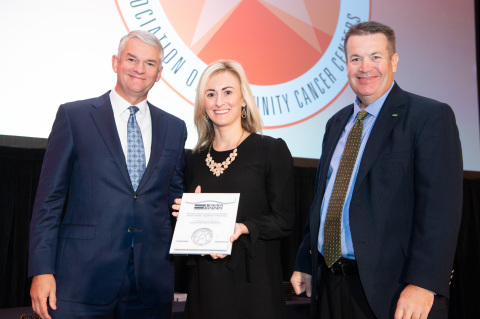CHAPEL HILL, N.C.--(BUSINESS WIRE)--At the 35th Annual National Oncology Conference, the Association of Community Cancer Centers (ACCC) recognized the UNC Department of Pharmacy and the North Carolina Cancer Hospital this past weekend as one of several forward-thinking cancer program members to create innovative strategies for the effective delivery of cancer care. The NC Cancer Hospital is UNC Lineberger’s clinical home.
Now in its eighth year, the Innovator Awards recognize ACCC member programs that have created inventive solutions to challenges commonly faced by cancer programs and practices, as well as the multidisciplinary care team. Lindsey Amerine, PharmD, MS, associate director of pharmacy at the UNC Medical Center in Chapel Hill, accepted the award and explained her team’s efforts in a blog post and in a presentation at the conference.
Total medication costs in hospitals and clinics have increased by 49 percent ($65.7 billion to $98.2 billion) from 2011 to 2016. Oncology and infusion agents, including antineoplastics and biologics, are the largest drivers in this price increase. Drug waste from the use of single-dose vials (SDV) for oncology and infusion agents is estimated to cost $1.8 billion annually.
In October 2011, UNC’s Department of Pharmacy implemented a drug vial optimization program (VIDEO), the first of its kind in the United States. Drug vial optimization is the extension of a drug vial’s sterility through the use of a closed-system transfer device – PhaSeal – up to the chemical stability of the drug or a maximum of 7 days, whichever is earlier. The process has led to significant financial, safety, and clinical outcomes.
“Through drug vial optimization, our organization has decreased drug waste by 94 percent from 2011 to 2016, saving UNC millions of dollars in drug expenses annually,” Amerine said. “The drug waste reduction program has also decreased the number of closed-system transfer devices needed, due to fewer vials being opened, thus requiring fewer vial protectors.”
During implementation of the drug vial optimization program, patient safety was a top priority, and it continues to be the medical center’s top priority while maintaining the program. The measurement of central line–associated bloodstream infections (CLABSI) is an indirect marker for patient safety. It is a sensitive measure that can be impacted by many activities (e.g., handwashing).
“So the goal of our program was not to experience a CLABSI rate increase after implementation,” Amerine said. “Instead, our CLABSI rate decreased following drug vial optimization implementation.” The NC Cancer Hospital was the first program in the nation to adopt a closed-system transfer device that has saved $43 million in drug expense annually by reducing waste.
Now in its eighth year, the ACCC Innovator Awards recognize ACCC member programs that have created inventive solutions to challenges commonly faced by cancer programs and practices, as well as the multidisciplinary care team.




